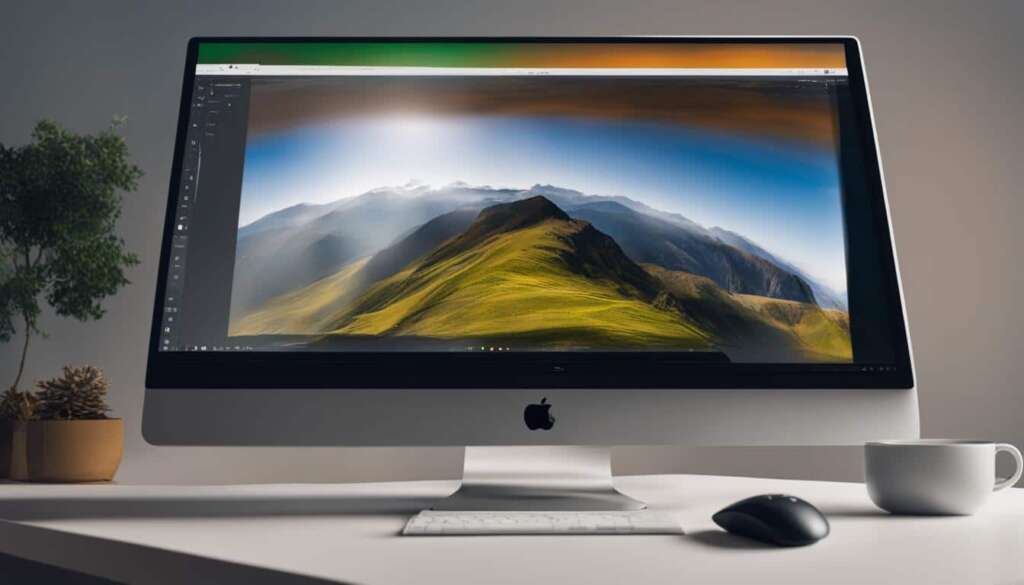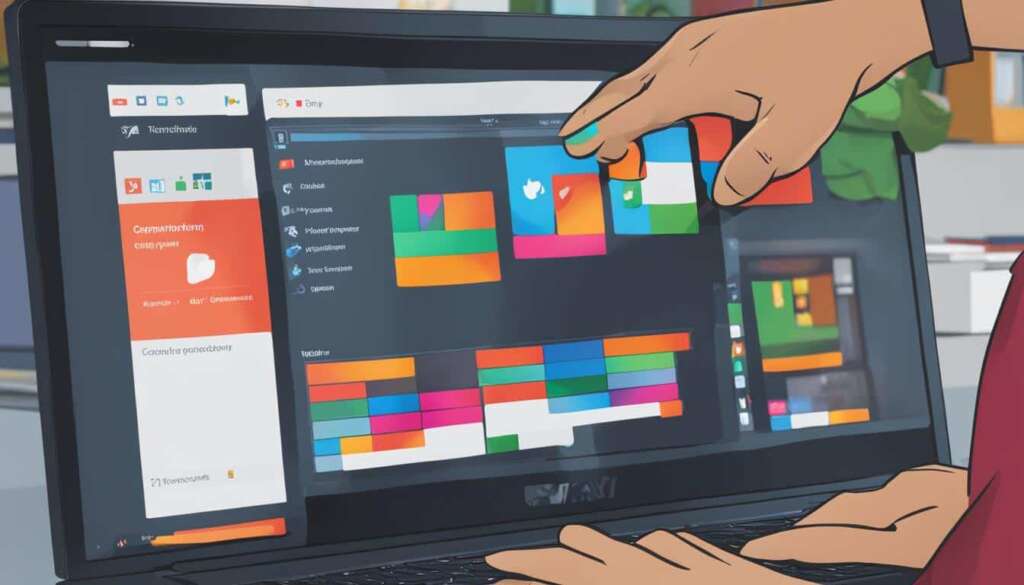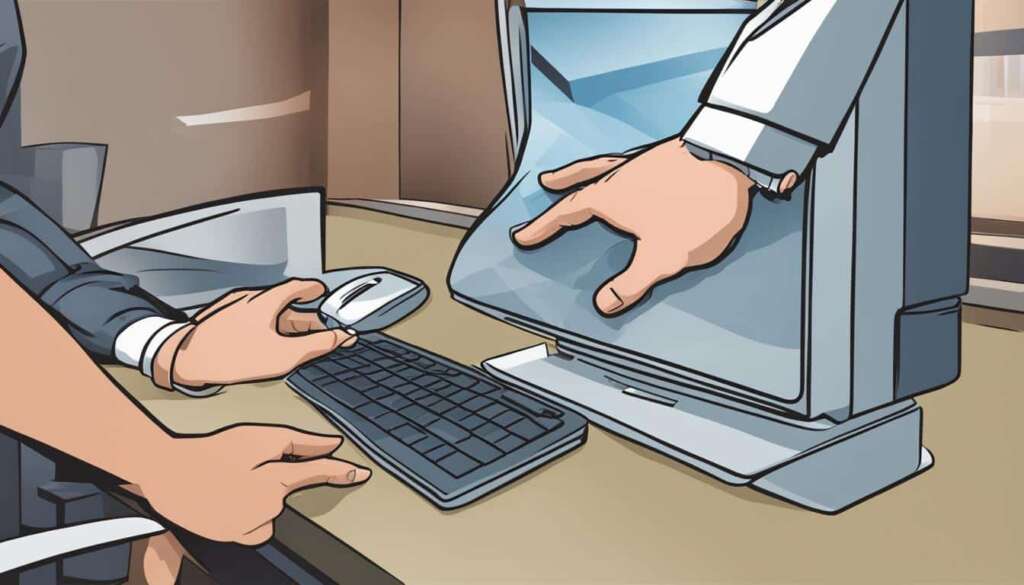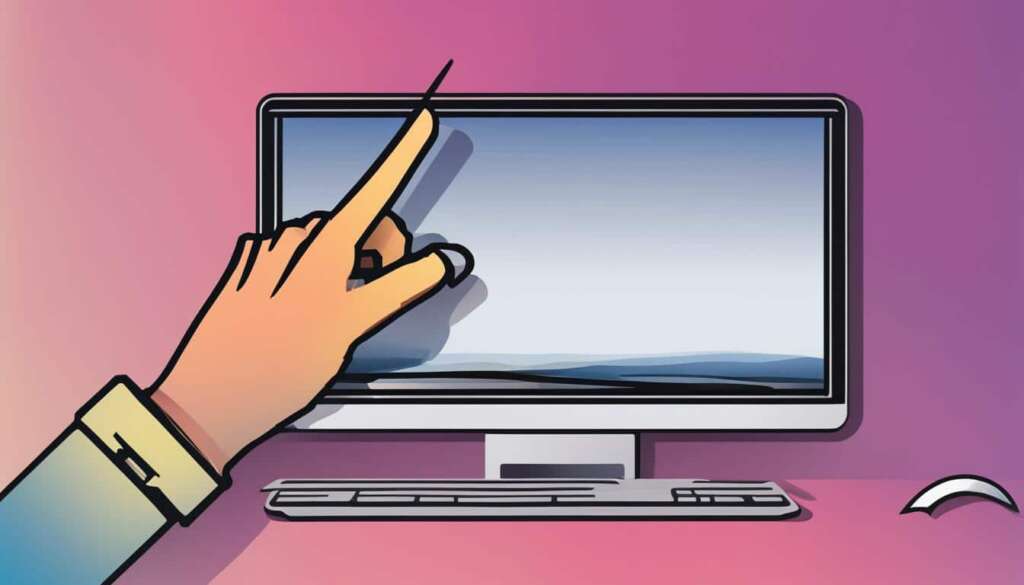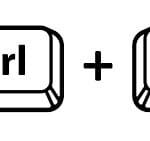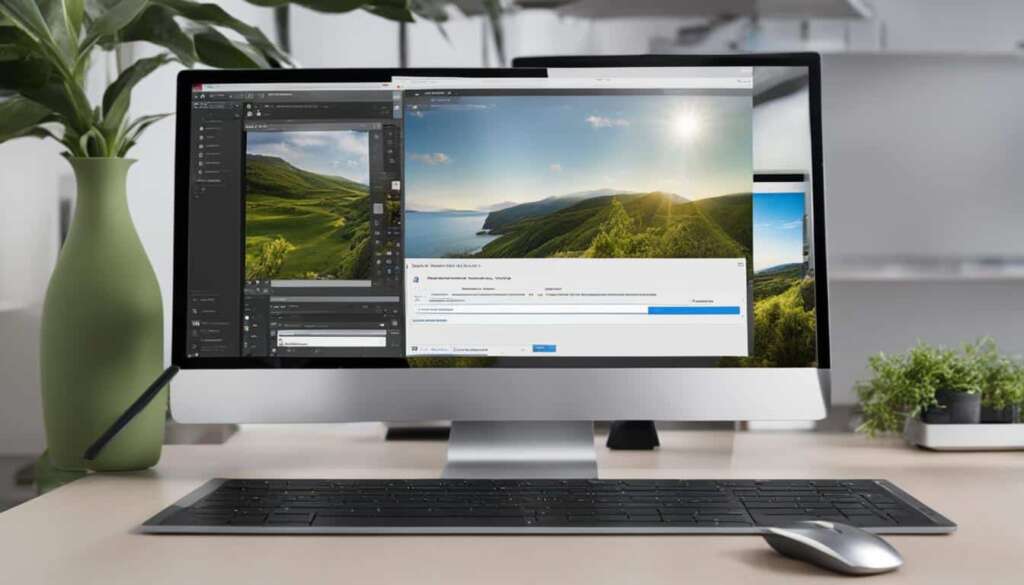Table of Contents
Have you ever wondered how to flip or rotate your computer screen? Whether you want to change the screen orientation, rotate your desktop screen, or flip your laptop or PC screen, this guide will teach you how to do it with ease. By following a few simple steps, you can transform your display to suit your preferences and enhance your viewing experience.
To get started, open the Windows search bar on your Windows 10 PC and type “rotate screen.” Select the “Open” option that appears. Alternatively, you can use keyboard shortcuts such as Ctrl + Alt + arrow keys to rotate or flip your screen.
Key Takeaways:
- To flip or rotate your computer screen on a Windows 10 PC, open the Windows search bar, and type “rotate screen.
- Choose an option from the Display Orientation drop-down menu to change the screen orientation.
- Use keyboard shortcuts like Ctrl + Alt + arrow keys for quick screen rotation.
- Rotating your computer screen can be helpful for viewing long texts, editing portrait images, and setting up a multi-display.
- Some computer screens may not be designed to be rotated, so check compatibility before attempting to rotate.
Why Rotate Your Computer Screen?
Rotating your computer screen can have various benefits and advantages. Whether you’re a professional who needs to view lengthy documents or images, or simply want to optimize your workspace, changing the screen orientation can improve your productivity. Here are some key reasons why you might consider rotating your computer screen:
Enhanced Reading and Editing Experience
Rotating your computer screen to a vertical orientation can make reading and editing long texts much easier. Instead of scrolling through lengthy documents or web pages, you can view the content in a more natural and convenient manner. This can be particularly helpful for researchers, writers, and students who often need to read and analyze extensive information.
Improved Image Editing
If you work with portrait images, rotating your computer screen can provide a more accurate and efficient editing experience. By rotating the screen, you can view the image in its intended orientation, making it easier to make precise edits and adjustments. Graphic designers, photographers, and artists can benefit from this feature, ensuring their work is accurate and visually appealing.
Optimized Workspace
Rotating your computer screen can also help optimize your workspace, especially when desk space is limited. By rotating the screen, you can take advantage of vertical space and set up multiple displays more effectively. This can be particularly useful for professionals who multitask or need to have multiple windows open simultaneously, such as programmers, video editors, and financial analysts.
As you can see, there are several benefits to rotating your computer screen. It can enhance your reading and editing experience, improve image editing accuracy, and optimize your workspace. Whether you need to view lengthy documents, edit portrait images, or multitask efficiently, rotating your computer screen can be a valuable feature to explore.
How to Rotate Your Computer Screen on Windows 7 and 8
Rotating your computer screen can be a useful feature, allowing you to adjust the display orientation to suit your needs. If you’re using Windows 7 or 8, the process to rotate your screen is simple and can be done in a few steps.
Step 1: Right-click on your desktop
To begin, right-click on your desktop background. This will open a context menu with various options.
Step 2: Select “Screen resolution” or “Display settings”
From the context menu, select either “Screen resolution” or “Display settings” depending on which option is available on your version of Windows.
Step 3: Choose the “Portrait” option
Once you’ve accessed the display settings, locate the “Orientation” drop-down menu. From here, choose the “Portrait” option to rotate your screen.
Alternatively, if you prefer using the Start menu, you can navigate to the display settings by going to Start, clicking on Control Panel, and selecting “Appearance and Personalization.” From there, choose “Display” and follow the same steps to select the “Portrait” option.
By following these simple steps, you can easily rotate your computer screen on Windows 7 and 8 to suit your desired orientation.

| Operating System | Method |
|---|---|
| Windows 7 and 8 | Right-click on desktop > Select “Screen resolution” or “Display settings” > Choose “Portrait” option |
| Windows 10 and 11 | Right-click on desktop > Select “Display settings” > Choose “Portrait” option |
How to Rotate Your Computer Screen on Windows 10 and 11
If you’re using a Windows 10 or 11 PC and want to rotate your computer screen, it’s a simple process that can be done through the display settings. Whether you need to flip your screen for a specific task or prefer a different orientation for better productivity, here’s how you can do it:
Step 1: Right-click on your desktop and select “Display settings.”
Start by accessing the display settings. Right-click anywhere on your desktop and choose the “Display settings” option from the context menu. This will open the screen settings for your Windows PC.
Step 2: Scroll down to find the “Display orientation” section.
Within the display settings, scroll down until you locate the “Display orientation” section. This is where you can make changes to the orientation of your computer screen. Click on the drop-down menu to reveal the available options.
To rotate your screen to a vertical orientation, select the “Portrait” option from the drop-down menu. This will change the orientation of your display to a portrait mode. You can also explore other options, such as landscape mode (the default setting), landscape (flipped) mode, or portrait (flipped) mode, depending on your preferences.
Rotating your computer screen can be useful for various tasks and scenarios. Whether you need a vertical orientation for reading long texts or coding, or simply prefer a different setup for your multi-display configuration, Windows 10 and 11 provide easy access to screen rotation settings. Experiment with different orientations to find what works best for your needs.
Using Keyboard Shortcuts to Rotate Your Computer Screen
Keyboard shortcuts can be a quick and convenient way to rotate or flip your computer screen without having to navigate through menus or settings. By memorizing a few simple combinations, you can easily change the screen orientation to suit your needs.
One commonly used keyboard shortcut is Ctrl + Alt + arrow keys. Pressing Ctrl + Alt + right or left arrow keys will rotate the screen 90 degrees to the right or left, respectively. This can be useful when working with software that requires a horizontal layout or when collaborating with others who may be viewing your screen from a different angle.
If you prefer to flip the screen upside down or bring it back to the standard orientation, you can use the Ctrl + Alt + up or down arrow keys. This is especially handy if you need to quickly switch between different tasks or if you accidentally rotate the screen in the wrong direction.
Remember, keyboard shortcuts can vary depending on your operating system and display settings. It’s always a good idea to check the documentation or support resources for your specific computer model to ensure you’re using the correct shortcuts.
| Keyboard Shortcut | Function |
|---|---|
| Ctrl + Alt + right arrow | Rotate screen 90 degrees to the right |
| Ctrl + Alt + left arrow | Rotate screen 90 degrees to the left |
| Ctrl + Alt + up arrow | Flip screen upside down |
| Ctrl + Alt + down arrow | Bring screen back to standard orientation |
Using keyboard shortcuts to rotate your computer screen can be a time-saving and efficient way to adjust your display settings. Whether you need to quickly switch between tasks or want to experiment with different orientations, mastering these shortcuts can enhance your productivity and make your computing experience more enjoyable.
Can All Computer Screens Be Rotated?
When it comes to rotating computer screens, not all monitors are created equal. Some screens are designed with adjustable mounts that allow for vertical screen orientation, providing flexibility in how you view your display. However, not all monitors have this capability, which is an important consideration if you’re looking to rotate your screen.
Before attempting to rotate your computer screen, it’s essential to check the compatibility of your monitor. If your monitor does not have an adjustable mount or the ability to rotate, you may need to invest in a new mount that is specifically designed for vertical screen orientation.
It’s also important to note that the compatibility of rotating screens can vary depending on the model of your computer. Older models may not support screen rotation, while newer models often have more flexibility in adjusting the display orientation.
Conclusion
Rotating or flipping your computer screen can be a useful feature for various tasks and situations. Whether you want to view long texts, edit portrait images, or optimize your workspace with a multi-display setup, knowing how to rotate your screen on Windows can enhance your productivity.
By following simple steps, you can easily flip your computer screen and change its orientation. Opening the Windows search bar and typing “rotate screen” will quickly lead you to the Display Orientation settings, where you can choose from different options like landscape mode, portrait mode, landscape (flipped) mode, or portrait (flipped) mode.
Keyboard shortcuts can also be used to rotate or flip your screen. Pressing Ctrl + Alt + arrow keys simultaneously allows you to rotate the screen in different directions, providing you with flexibility and convenience.
Experiment with different screen orientations to find the one that works best for your needs. Whether it’s for work or leisure, flipping your computer screen can bring numerous benefits and improve your overall user experience.
FAQ
How do I flip my computer screen on a Windows 10 PC?
To flip your computer screen on a Windows 10 PC, open the Windows search bar, type “rotate screen,” and click Open. From the Display Orientation drop-down menu, choose an option such as landscape mode, portrait mode, landscape (flipped) mode, or portrait (flipped) mode. You can also use keyboard shortcuts such as Ctrl + Alt + arrow keys to rotate or flip your screen.
Why would I want to rotate my computer screen?
Rotating your computer screen to a vertical orientation can be beneficial for tasks such as viewing long texts, editing portrait images, and coding. It can also be helpful for setting up a multi-display when desk space is limited.
How do I rotate my computer screen on Windows 7 and 8?
To rotate your computer screen on Windows 7 and 8, right-click on your desktop, select “Screen resolution” or “Display settings,” and choose the “Portrait” option from the drop-down menu next to “Orientation.” Alternatively, you can access the display settings through the Start menu and navigate to the “Portrait” option.
How do I rotate my computer screen on Windows 10 and 11?
To rotate your computer screen on Windows 10 and 11, right-click on your desktop and select “Display settings.” Scroll down to find the “Display orientation” section and choose the “Portrait” option from the drop-down menu. You can also access the display settings through the Start menu and select “Display” to find the “Portrait” option.
Can I use keyboard shortcuts to rotate my computer screen?
Yes, you can use keyboard shortcuts to rotate your computer screen. Pressing Ctrl + Alt + arrow keys simultaneously can rotate or flip your screen in different directions. For example, Ctrl + Alt + right/left arrow keys can rotate the screen 90 degrees right or left, while Ctrl + Alt + up/down arrow keys can flip the screen upside down or bring it back to the standard orientation.
Can all computer screens be rotated?
Not all computer screens are designed to be rotated. Some monitor mounts are adjustable and can support vertical screen orientation, while others do not have this capability. If your mount does not support vertical orientation, you may need to buy a new mount specifically designed for that purpose. It’s important to check your PC model and research compatible mounts if you want to permanently rotate your screen.
Why should I consider rotating my computer screen?
Rotating or flipping your computer screen can be a useful feature for various tasks and situations. Whether you want to view long texts, edit portrait images, or optimize your workspace with a multi-display setup, knowing how to rotate your screen on Windows can enhance your productivity. Experiment with different orientations and find the one that works best for your needs.

